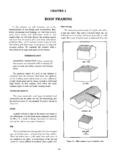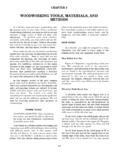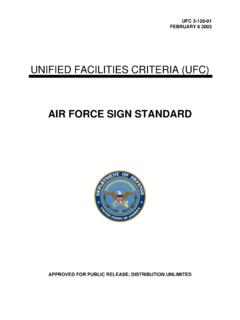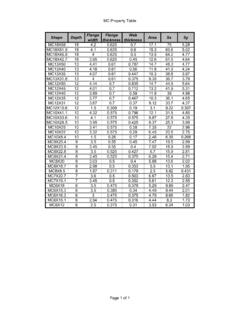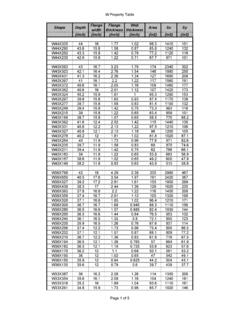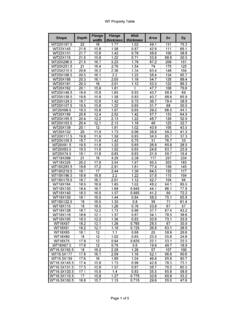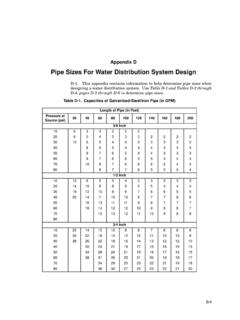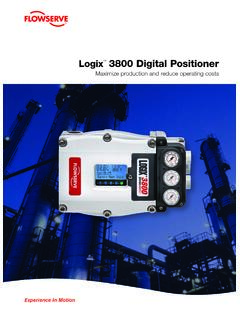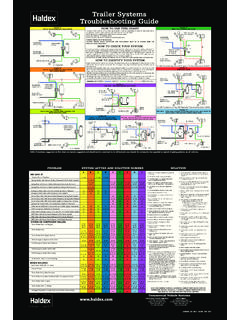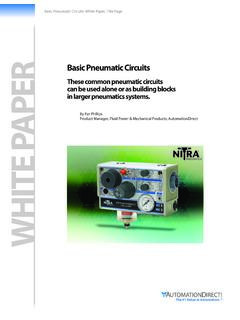Transcription of MECHANICAL SCIENCE Module 4 Valves
1 Department of EnergyFundamentals HandbookMECHANICAL SCIENCEM odule 4 ValvesREFERENCESDOE-HDBK-1018/2-93 ValvesREFERENCES Babcock & Wilcox, Steam, Its Generation and Use, Babcock & Wilcox Co., 1978. Cheremisinoff, N. P., Fluid Flow, Pumps, Pipes and Channels, Ann Arbor SCIENCE . Heat Transfer, Thermodynamics and Fluid Flow Fundamentals, Columbia, MD, GeneralPhysics Corporation, Library of Congress Card #A 326517, 1982. Schweitzer, Philip A., Handbook of Valves , Industrial Press Inc. Stewart, Harry L., Pneumatics & Hydraulics, Theodore Audel & Company, viRev. 0 ValvesDOE-HDBK-1018/2-93 VALVE FUNCTIONS AND BASIC PARTSVALVE FUNCTIONS AND BASIC PARTSV alves are the most common single piece of equipment found in DOE there are many types, shapes, and sizes of Valves , they all have thesame basic parts.
2 This chapter will review the common parts and functions of the four basic types of flow control elementsemployed in valve how valve stem leakage is a drawing of a valve, IDENTIFY the valve is a MECHANICAL device that controls the flow of fluid and pressure within a system orprocess. A valve controls system or process fluid flow and pressure by performing any of thefollowing functions: Stopping and starting fluid flow Varying (throttling) the amount of fluid flow Controlling the direction of fluid flow Regulating downstream system or process pressure Relieving component or piping over pressureThere are many valve designs and types that satisfy one or more of the functions identifiedabove. A multitude of valve types and designs safely accommodate a wide variety of of type, all Valves have the following basic parts: the body, bonnet, trim (internalelements), actuator, and packing.
3 The basic parts of a valve are illustrated in Figure 0ME-04 Page 1 VALVE FUNCTIONS AND BASIC PARTSDOE-HDBK-1018/2-93 ValvesValve BodyThe body, sometimes called the shell, is the primary pressure boundary of a valve. It serves asthe principal element of a valve assembly because it is the framework that holds body, the first pressure boundary of a valve, resists fluid pressure loads from connectingpiping. It receives inlet and outlet piping through threaded, bolted, or welded bodies are cast or forged into aFigure 1 Basic Parts of a Valvevariety of shapes. Although a sphereor a cylinder would theoretically bethe most economical shape to resistfluid pressure when a valve is open,there are many other example, many Valves require apartition across the valve body tosupport the seat opening, which is thethrottling orifice.
4 With the valveclosed, loading on the body isdifficult to determine. The valve endconnections also distort loads on asimple sphere and more complicatedshapes. Ease of manufacture,assembly, and costs are additionalimportant considerations. Hence, thebasic form of a valve body typicallyis not spherical, but ranges fromsimple block shapes to highlycomplex shapes in which the bonnet,a removable piece to make assemblypossible, forms part of the pressure-resisting of the fluid passage(venturi effect) is also a commonmethod for reducing the overall sizeand cost of a valve. In otherinstances, large ends are added to thevalve for connection into a 0 Page 2 ValvesDOE-HDBK-1018/2-93 VALVE FUNCTIONS AND BASIC PARTSV alve BonnetThe cover for the opening in the valve body is the bonnet.
5 In some designs, the body itself issplit into two sections that bolt together. Like valve bodies, bonnets vary in design. Somebonnets function simply as valve covers, while others support valve internals and accessoriessuch as the stem, disk, and bonnet is the second principal pressure boundary of a valve. It is cast or forged of the samematerial as the body and is connected to the body by a threaded, bolted, or welded joint. In allcases, the attachment of the bonnet to the body is considered a pressure boundary. This meansthat the weld joint or bolts that connect the bonnet to the body are pressure-retaining bonnets, although a necessity for most Valves , represent a cause for concern. Bonnets cancomplicate the manufacture of Valves , increase valve size, represent a significant cost portionof valve cost, and are a source for potential TrimThe internal elements of a valve are collectively referred to as a valve's trim.
6 The trim typicallyincludes a disk, seat, stem, and sleeves needed to guide the stem. A valve's performance isdetermined by the disk and seat interface and the relation of the disk position to the of the trim, basic motions and flow control are possible. In rotational motion trimdesigns, the disk slides closely past the seat to produce a change in flow opening. In linearmotion trim designs, the disk lifts perpendicularly away from the seat so that an annular and SeatFor a valve having a bonnet, the disk is the third primary principal pressure disk provides the capability for permitting and prohibiting fluid flow. With the diskclosed, full system pressure is applied across the disk if the outlet side is this reason, the disk is a pressure-retaining part.
7 Disks are typically forged and, insome designs, hard-surfaced to provide good wear characteristics. A fine surface finishof the seating area of a disk is necessary for good sealing when the valve is closed. Mostvalves are named, in part, according to the design of their seat or seal rings provide the seating surface for the disk. In some designs, the bodyis machined to serve as the seating surface and seal rings are not used. In other designs,forged seal rings are threaded or welded to the body to provide the seating surface. Toimprove the wear-resistance of the seal rings, the surface is often hard-faced by weldingand then machining the contact surface of the seal ring. A fine surface finish of theseating area is necessary for good sealing when the valve is closed. Seal rings are notusually considered pressure boundary parts because the body has sufficient wall thicknessto withstand design pressure without relying upon the thickness of the seal 0ME-04 Page 3 VALVE FUNCTIONS AND BASIC PARTSDOE-HDBK-1018/2-93 ValvesStemThe stem, which connects the actuator and disk, is responsible for positioning the are typically forged and connected to the disk by threaded or welded joints.
8 Forvalve designs requiring stem packing or sealing to prevent leakage, a fine surface finishof the stem in the area of the seal is necessary. Typically, a stem is not considered apressure boundary of the disk to the stem can allow some rocking or rotation to ease thepositioning of the disk on the seat. Alternately, the stem may be flexible enough to letthe disk position itself against the seat. However, constant fluttering or rotation of aflexible or loosely connected disk can destroy the disk or its connection to the types of valve stems are rising stems and nonrising stems. Illustrated in Figures 2and 3, these two types of stems are easily distinguished by observation. For a rising stemvalve, the stem will rise above the actuator as the valve is opened.
9 This occurs becausethe stem is threaded and mated with the bushing threads of a yoke that is an integral partof, or is mounted to, the 2 Rising StemsME-04 Rev. 0 Page 4 ValvesDOE-HDBK-1018/2-93 VALVE FUNCTIONS AND BASIC PARTSF igure 3 Nonrising StemsThere is no upward stem movement from outside the valve for a nonrising stem the nonrising stem design, the valve disk is threaded internally and mates with thestem ActuatorThe actuator operates the stem and disk assembly. An actuator may be a manually operatedhandwheel, manual lever, motor operator, solenoid operator, pneumatic operator, or hydraulicram. In some designs, the actuator is supported by the bonnet. In other designs, a yokemounted to the bonnet supports the for certain hydraulically controlled Valves , actuators are outside of the pressure , when used, are always outside of the pressure PackingMost Valves use some form of packing to prevent leakage from the space between the stem andthe bonnet.
10 Packing is commonly a fibrous material (such as flax) or another compound (suchas teflon) that forms a seal between the internal parts of a valve and the outside where the stemextends through the packing must be properly compressed to prevent fluid loss and damage to the valve'sstem. If a valve's packing is too loose, the valve will leak, which is a safety hazard. If thepacking is too tight, it will impair the movement and possibly damage the 0ME-04 Page 5 VALVE FUNCTIONS AND BASIC PARTSDOE-HDBK-1018/2-93 ValvesIntroduction to the Types of ValvesBecause of the diversity of the types of systems, fluids, and environments in which Valves mustoperate, a vast array of valve types have been developed. Examples of the common types arethe globe valve, gate valve, ball valve, plug valve, butterfly valve, diaphragm valve, check valve,pinch valve, and safety valve.
